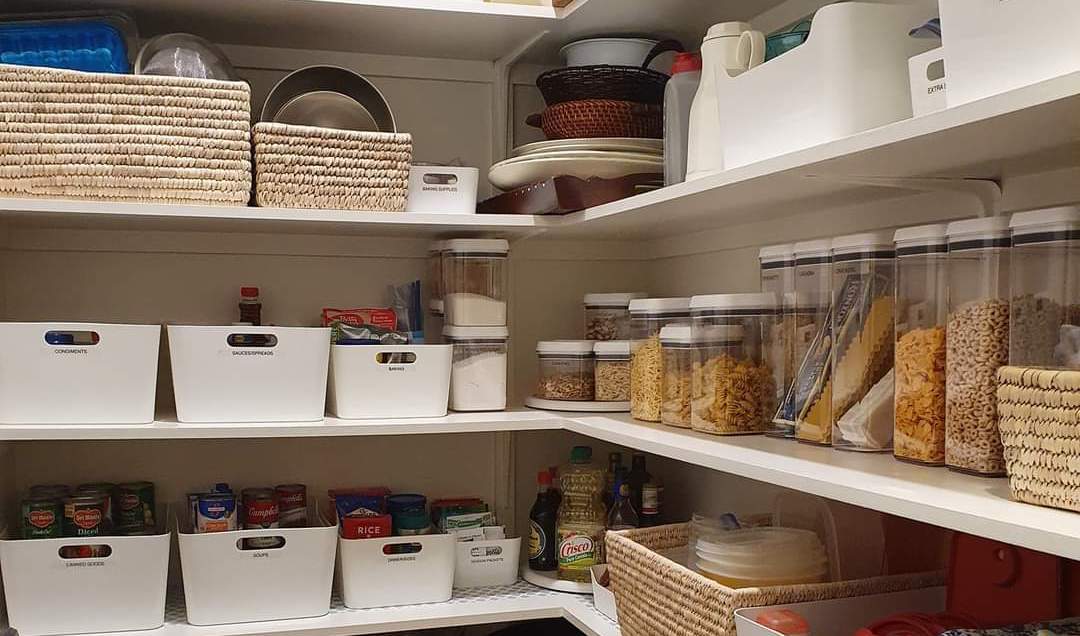These pro tips will show you how to keep your pantry organized—whether yours is walk-in size or part of a cupboard.
We all have days when we’re rushing like crazy, with NO time to spare (is that the norm in your house too?). Groceries get thrown in the cart, then shoved into pantry spaces willy-nilly… and before you know it, dinner takes twice as long because you can’t find the ingredients that you’re SURE you bought last time.
Or you end up tossing things out because they’ve expired. Or you start storing things on the counter or in the hall closet because you’re out of room but there’s still nothing to eat!).
Having a plan for how to keep your pantry organized, I’ve discovered, is the key to a triple crown of happiness:
- Save time (SO much less searching!).
- Less mental energy and stress (you barely have to think about what to do because it’s habit).
- Less waste/more savings (because you can find, and even see, what you have, more easily).
The key is a plan, or system, that fits how you think, and what you use. These steps are at the heart of every pantry organization project I do—and they can help you, too!
STEP #1: Zones and categories
Grouping items together based on when and how they’re needed or your family’s routines can really simplify snack- and mealtime for everyone—and make it easier to put groceries away, too.
Start by thinking about how you and your family eat, and how your pantry can function to make life easier. Some common groupings:
- Zones: breakfast items, snack foods, grab-n-go options, kids’ section, dinner prep, baking, etc.
- Categories: used more to group “like” items, you might want to set aside spaces for canned goods, spices, teas, pasta, etc.
Get specific: maybe your family needs specialized ones such as: gluten free, adult snacks vs kid snacks, smoothie ingredients, etc.
And for the kids’ section: If you want little ones to get their own snacks and/or breakfast foods, it’s critical to put them in easy-access containers—e.g., wide openings—so they can grab them without messing everything up. And of course, the younger (i.e. shorter) they are, the lower the shelf or drawer.
From there, think about what gets used and needs accessed most often – those are the items that should go front and center in the most accessible space available.
BONUS TIP: Remembering to keep “like with like”—where all pantry items used for the same or similar purpose go in the same area—is the secret to how to keep your pantry organized. You can use it for sorting refrigerator, freezer, and/or bulk storage areas, too.
STEP #2: Toss the Outer Packaging
The extra packaging designed to keep individual packs of just about anything together, actually eats up valuable storage space in your pantry! Plus, it’s hard to know how much you have and when you need to add it to the grocery list because, inevitably, SOMEONE takes the last item and leaves an empty box on the shelf for you to find!
- Remove things like granola bars, fruit cups, canned goods, oatmeal packets, individual snack bags, etc., from its bulky outer packaging.
- Stack items, or transfer to designated containers (clear ones help you see what you have; opaque give a neat-and-tidy look, but you’ll need to pull them out to check supply).
Containment is fine for anything and everything if you like the look, but items that absolutely MUST be contained are those that will fall or flop into other areas, and can’t maintain their space: chocolate chips, potato chips, seasoning packets, oatmeal packets, small items like granola bars, etc.
STEP #3: Think UP
Unfortunately, basic pantry, cupboard, and closet spaces are generally not designed to make the most use of your floor-to-ceiling space. But you, knowing the items you want to store (because they’re likely jamming up your spaces right now), can see the heights of the items you want to accommodate—and then put that space to use.
Yes, you’d be amazed at how much extra storage you have once you maximize your vertical space!
- Use tiered shelves for canned goods and jars. Just like stadium seating allows everyone to see the performance, tiered shelving lets you see everything, so you’re less likely to forget about what you have (letting it expire or re-buying because you didn’t know you had it!).
- Space shelves to suit your needs. Here’s how: first, lay out the items you want to store on a table, in the categories or zones you set up in Tip #1. Use a ruler to measure the height of the items (individual or stacked) that you’d like to store on various shelves. Now, adjust the shelves you have, and/or add new ones, to fit the items you’d like to group together.
- Stackable containers are another option to help you maximize your vertical space. Just avoid putting frequently-needed items in stacks of more than two; if you or your family have to do too much juggling, the system will break down fast!
Check out my recommended kitchen products for some of the best I’ve found!
And one more easy answer to “How to keep your pantry organized?”…
STEP #4: Use turntables in corners
The deepest recesses of the corners of the pantry are dead zones where things get lost. Turntables give you equal access to everything, eliminating the dead zone! Common favorites:
- Oils, sauces, dressings, and any bottles and jars heavy enough not to fall over when you spin the turntable.
- Peanut butter, jelly, honey (all great for a breakfast zone!), and/or other spreads/condiments.
So, now you no longer need to wonder how to keep your pantry organized… it’s time to get started! I promise, once you have these basic steps in place, unloading the groceries will go more easily—you’ll know right where to put everything—and you’ll find meal prep goes faster and easier too. If you get stuck along the way though, feel free to call in reinforcements, like me at SOS by Lisa; I’ll help you make sense of the chaos!

